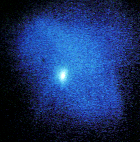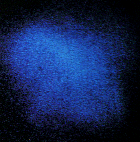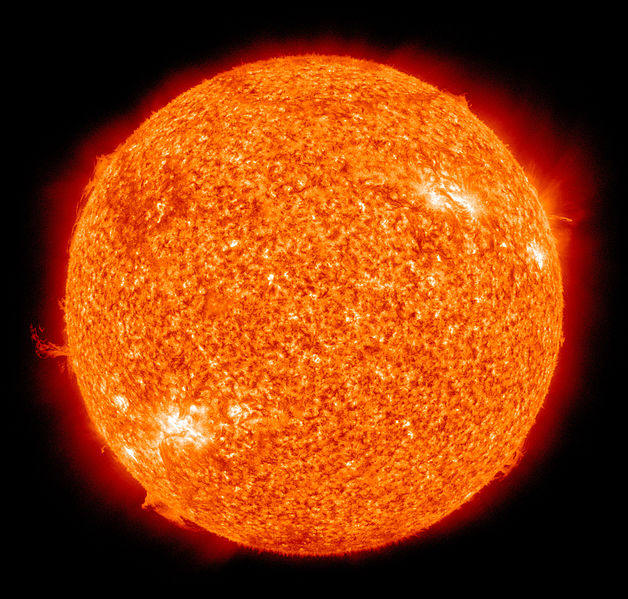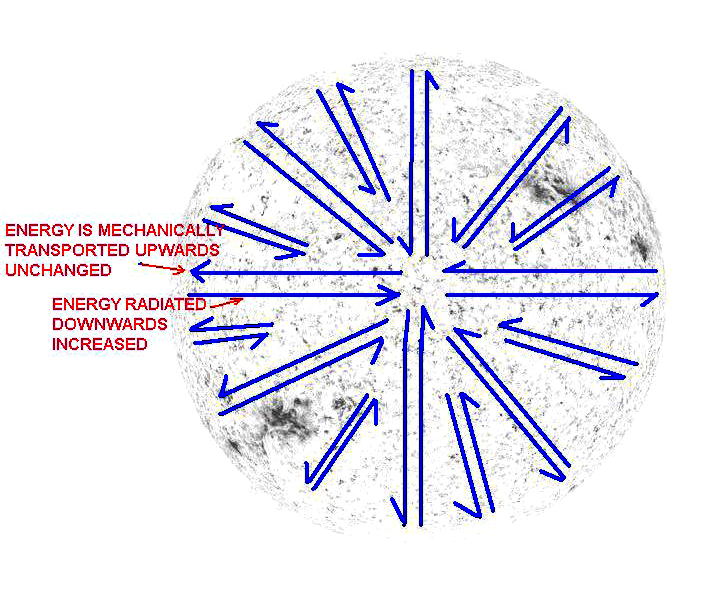
COPY RIGHT, ALL RIGHTS RESERVED BY PROFESSOR, DOCTOR, PT PAPPAS, 20/2/2012. IN PART OR IN WHOLE OR ITS ESSENCE MIGHT BE REPRODUCED, PROVIDED REFERENCE IS MADE TO THE PRESENT AND TO ITS AUTHOR.
STAR GENESIS
SEE ALSO
(4.17301)
IDEAL FREE ENERGY OSCILLATOR, AND
PULSARS
GRAVITATIONAL FIASCO FOR GENERAL RELATIVITY,
RELATIVISTIC MECHANICS FOR
ENERGY NON CONSERVATION, BASED
ON VERIFIED PHYSICAL LAWS, (COMBINATION OF WHICH CAUSES ENERGY CREATION,
PROOF OF NON CONSERVATION OF ENERGY)
ΕΝΕΡΓΕΙΑ ΦΩΤΟΝΙΟΥ
energy of photon
Ε=hv
ΙΣΟΔΥΝΑΜΟΣ ΜΑΖΑ ΦΩΤΟΝΙΟΥ
equivalent mass of photon
E=mc2, m0=hv0/c2
ΑΝΑΓΚΑΙΟ ΕΡΓΟ W ΜΕΤΑΦΟΡΑΣ ΦΩΤΟΝΙΟΥ
ΚΑΤΑ ΚΑΤΑΚΟΡΥΦΟ ΥΨΟΣ ΔX:
needed work W for
transport of height
ΔX:
(http://en.wikipedia.org/wiki/Pound-Rebka_experiment
of 1959.):
The detector at the bottom sees a superposition of the two effects. The Emitter was moved vertically and the speed was varied until the two effects cancelled each other, a phenomenon detected by reaching resonance. Mathematically:

In the case of the Pound–Rebka experiment
 .
Therefore:
.
Therefore:
 =
7.5×10−7 m/s
=
7.5×10−7 m/sIn the more general case when h ≈ R the above is no longer true. The energy associated with gravitational redshift over a distance of 22.5 meters is very small. The fractional change in energy is given by δE/E, is equal to gh/c2 = 2.5×10−15. Therefore short wavelength high energy photons are required to detect such minute differences. The 14 keV gamma rays emitted by iron-57 when it transitions to its base state proved to be sufficient for this experiment.
W=hΔν=m0gΔx,
hΔν=m0gΔx=hv0/c2.gΔx , since m0=E/c2=hv0/c2
|
Δν=v0/c2.gΔx Δν/v0=1/c2.gΔx
ΔE/E0=1/c2.gΔx
FOR MECHANICAL ROTATIONAL, TRANSPORT. ELECTRICAL etc.. ENERGY: ΔE/E0=0 see below |
Δν/v0=1/c2.gΔx=1/9.1016.10Δx=10-18
Δx= ΣΧΕΤΙΚΗ ΑΠΟΚΛΙΣΗ,
relevant deviation, practical zero, non
observable,
ΠΡΑΚΤΙΚΑ ΜΗΔΕΝ ΚΑΙ ΜΗ
ΜΕΤΡΙΣΙΜΗ, ΔΙΑ ΚΑΘΕ ΤΡΕΧΟΝ ΓΑΛΛΙΚΟ ΜΕΤΡΟ
Δx,
for every linear French meter
Δx
,
ΔΙΟΤΙ ΞΕΦΕΥΓΕΙ ΑΠΟ ΤΑ ΟΡΙΑ
for exceeds the limits
ΔΥΝΑΤΟΤΗΤΩΝ ΤΗΣ
ΣΗΜΕΡΙΝΗΣ
of
capability of today's
ΤΕΧΝΟΛΟΓΙΑΣ ΓΙΑ ΝΑ ΜΕΤΡΗΣΕΙ ΑΜΕΣΑ.
technology to directly observe.
ΨΕΜΑ ΤΩΝ ΥΠΟΣΤΗΡΙΚΤΩΝ ΤΗΣ Γ.Θ.Σ.
lies of supporters of GR.
ΠΟΥ ΥΠΟΣΤΗΡΙΖΕΙ ΟΤΙ ΜΟΝΟ ΤΑ ΜΑΘΗΜΑΤΙΚΑ ΑΥΤΗΣ ΤΗΣ ΘΕΩΡΙΑΣ ΑΠΟΔΕΙΚΝΥΕΤΑΙ Η ΠΑΡΑΚΑΤΩ ΕΡΥΘΡΑ 'Η ΜΠΛΕ ΜΕΤΑΤΟΠΙΣΗ, ΣΥΝΕΠΕΙΑ ΒΑΡΥΤΙΚΟΥ ΠΕΔΙΟΥ.
ΔΙΑ ΑΣΤΡΟΝΟΜΙΚΕΣ ΚΛΙΜΑΚΕΣ:
for astronomical scale:
dν/v0=1/c2.gdx,
με g=GM/r2 ,
ΑΡΑ
therefore
dν/v0=1/c2.GM/r2.dx
ΑΡΑ
therefore
for the
distance starting SUN to EARTH,
the integral is:
Δν/v0=-1/c2.GM/r
=(-1/9.10-16).6.674.10-11.M/r =
-10-17.6.674.10-11.1,9891 × 1030 kg/1,392×10-9 m = περιπου -approximately-
-10-7
ΠΡΑΓΜΑΤΙ (-17-11-6-3+30)=-7.
indeed.
ME
with
(ΓΙΑ ΤΟΝ ΗΛΙΟ ΜΑΣ)
(for our sun)
MKS UNITS:
G=6.674.10-11, r = 1,392×106×103m, M=1,9891×1030
kgr
Equatorial
radius
6.955×105 km,
Mean distance
from
Earth 1.496×108 km,
sun's g on the distance of earth =GM/r2=10-11x1030x10-22x6.674x1.9892/2=approximately=6.67x10-3
m/s2=10-5g of surface on earth!
ln\E\=INT0R(1/c2.gdx)+ln\E0\
ln\E/E0\=INT0R(1/c2.gdx)
E/E0=EXP(INT0R1/c2.gdx)
EXP(1/c2.gINT0R dx)=EXP(1/c2.g.R)=EXP(1/9.10-16.270.6.955.108)=EXP(1877.85.109)=
2,718281,87785.1012=which
makes every computer to over flow!,
10x=2,71828, xlog10=log2,71828
x=log2,71828=0,43429, therefore,
|
E=E0. 10(0,43429.1,18775.1012) The
above dependence of the produced energy, on the existing energy in a star, and whether this
energy may or may not escape the globe of the star, indicates that the
star's activity may oscillate, as it happens for the sun with period of
11 years and for the most of the stars, with especially, otherwise,
unexplained variation of brightness of natural or artificial pulsar stars. |
click here for proof of oscillations
Star name, Solar masses
(Sun = 1)
R136a1 [1]
265–320
WR 101e 150–160
HD 269810
150 Peony
Nebula Star 150
LBV
1806-20 130–200
HD 93129 A
+ B[2][3]
A=120–127, B=80
HD 93250 118
NGC
3603-A1 A=116, B=89
Pismis
24-1 A + B[4][5]
A=100–120, B=100
Arches cluster[6][7][8]
Many stars, 100–130
Pismis
24-17[5]
100
Hineliun 100
S Doradus
100 Eta
Carinae[9]
90–100
Cygnus OB2-12 92
WR20 a
+ b[10]
A=83, B=82
The Pistol Star 80–150
Melnick 42[11][12][13]
80–100 HD 97950[14][15]
80
Sk-71 51[16]
80
R 126 70 Companion to M33 X-7[17]
70 LY
Aurigae 64
LH54-425 A + B[18]
A=62, B=37 Var 83
in M33[19]
60–85 Sher 25
in NGC 3603[20]
60
Zeta-1 Scorpii[21]
60 Zeta
Puppis[22]
59
WR22[23]
55–74
Plaskett A + B[24][25]
A=43, B=51
AG Carinae 50
WR102c[26]
45–55
IRS-8*[27]
44.5 HD 5980
A + B[28][29][30]
A=40–62, B=30
DL Crucis 40–50
Epsilon Orionis 40
HD 148937[31][32]
40
IRAS 05423-7120[16]
40
Rho Cassiopeiae 40
RW Cephei
40
Theta1 Orionis C 40
Xi Persei[33]
40 V382
Carinae 39 Companion to NGC300 X-1[34]
38 Cluster
R136a 12 stars, all 37–76
Chi2 Orionis[35]
35–40 Companion to IC10 X-1[36]
35 Nu
Aquilae 30-45
VY Canis Majoris[37][38]
30–40 19
Cephei 30–35
Gamma
Velorum A 30
P Cygni 30
R 66 30
Eta Canis Majoris 30
Zeta
Orionis 28
IRS 15[39]
26 VV Cephei
25–40
Alpha Camelopardalis[40][41]
25–30
6 Cassiopeiae[42][43]
25
EZ Canis Majoris 25
KY Cygni[44]
25 Mu Cephei
25
V509 Cassiopeiae 25
NGC 7538 S[45]
20–40
S Monocerotis A[46]
18–30
WR47 8–48
H ΑΠΟΚΛΙΣΗ -10-7,
ΒΓΑΛΜΕΝΗ ΜΕ ΤΗΝ ΚΛΑΣΣΙΚΗ
the deviation
-10-7,
derived by classical
physics, without GR, that should be observable
ΦΥΣΙΚΗ, ΟΧΙ
ΤΗΝ ΓΘΣ ΠΟΥ ΠΡΕΠΕΙ ΝΑ
ΠΑΡΑΤΗΡΕΙΤΑΙ ΚΑΙ ΠΑΡΑΤΗΡΕΙΤΑΙ,
and it is observred
ΦΑΒΑ ΤΗΣ ΓΘΣ.
scam of GR.
ΓΕΝΙΚΗ ΣΧΕΤΙΚΟΤΗΣ
for GR
ν1 = ν2 ( 1+gx/c2 ) , ν1-ν2 =ν2gx/c2 το ιδιο με το δικο μας παραπανω:Δν=v0/c2.gx
ν1 =ν2( 1+φ/c2 )
The schematics 4, 5 to be added below

schematic 1
v2>v1,
due to the existing gravity of the celestial body, meaning that the Energy of
the E/M radiation, arriving at the receiver, is grater, than the Energy of the
E/M emitted at the emitter,
(click below, to see the experiment,
confirming the change of frequency in gravitational field)
http://en.wikipedia.org/wiki/Pound-Rebka_experiment
of 1959.
Never, the less, the Energy going back MECHANICALLY
(ROTATIONALLY) IS UNCHANGED, except some energy only changes at the beginning to
deformation. THEREFORE, THE TOTAL ENERGY OF THE CLOSED LOOP IS CONSTANTLY
INCREASING, UNLESS, SOME OF IT ESCAPES AWAY, LIKE IN A STAR SOME ENERGY ESCAPES AWAY,
FOR EXAMPLE, FROM OUR SUN, A SMALL PART OF ENERGY CONSTANTLY ESCAPES AWAY.
ΜΕΘΟΔΟΙ ΜΕΤΑΦΟΡΑΣ ΘΕΡΜΟΤΗΤΟΣ,
Methods of heat transfer,
ΜΕΤΑΦΟΡΑΣ, ΑΚΤΙΝΟΒΟΛΙΑΣ,
by convection, radiation,
ΑΓΩΓΙΜΟΤΗΤΟΣ. ΤΑ ΔΥΟ ΤΕΛΕΥΤΑΙΑ
conduction. The last two
ΕΙΝΑΙ ΚΑΙ ΤΑ ΔΥΟ ΑΚΤΙΝΟΒΟΛΙΑΣ (ΑΠΟ
are both by radiation (from
ΑΤΟΜΟ ΣΕ ΑΤΟΜΟ, ΓΙΑ ΤΙΣ ΔΥΟ ΤΕΛΕΥΤΑΙΕΣ ΠΕΡΙΠΤΩΣΕΙΣ)
atom to atom, for the last two cases)
ΑΡΑ ΚΑΤ' ΟΥΣΙΑΝ ΥΠΟΚΕΙΝΤΑΙ ΣΕ
Therefore they are subject to
ΒΑΡΥΤΙΚΗ ΑΛΛΟΙΩΣΗ, ΕΝΩ ΔIA
gravitational alteration, however for
ΜΕΤΑΦΟΡΑΣ ΔΕΝ ΥΠΟΚΕΙΤΑΙ ΣΕ
convection is not subject to
ΑΛΛΟΙΩΣΗ.
alteration.
ΣΕ ΑΥΤΟ ΣΥΝΙΣΤΑΤΑΙ ΤΟ ΘΕΩΡΗΜΑ Π.
This consists of the theorem of P.
ΠΑΠΠΑΣ, ΔΗΜΙΟΥΡΓΙΑΣ ΕΝΕΡΓΕΙΑΣ KAI
Pappas, for the creation of energy and
ΜΑΖΗΣ ΣΤΑ ΑΣΤΡΙΚΑ ΣΩΜΑΤΑ.
mass in celestial bodies.
....PARTICULARLY, EVIDENT, IN THE NEED OF ASSUMING OF THE DARK MATTER AND DARK ENERGY, FOR THE INCREASE OF ENERGY AND MASS, IN STAR SCALE.
schematic 2, ENERGY MULTIPLIER AND EFFECTIVELY INCREASING THE DISTANCE BETWEEN EMITTER AND RECEIVER.
SCHEMATIC 3. NATURAL ENERGY CREATION BY A VOLCANO.
HEAT IS FIRST MECHANICALLY TRANSPORTED UP, THEN IT IS RADIATED BACK OR EQUIVALENTLY
CONDUCTED BACK (BACK RADIATED AND ABSORBED FROM TO ATOM BACK TO ITS ORIGIN), THUS, IT INCREASES
LITTLE BY LITTLE BACK, AND
EVENTUALLY MAKES THE VOLCANO TO EXPLODE.

We should also take into account, that g is thousands of times bigger inside a BIG celestial body, due to the increased gravity (in terms of pressure) in the interior. The assumed mean density of the earth is 5.5 gr/cm3, without being able to tell the actual inside peak value, that in the central point (center), reaching too big vales of million times. FOR EXAMPLE:
 |
 |
PHOTOGRAPHS 4
The, otherwise, unexplained
variation of brightness of natural or artificial pulsar stars with strange
intelligent modes, According to the ideas and the implied technology for super
civilizations.
See NASA'S
site (SETI)
http://openseti.org/OSPulsars.html and my friend
PAUL'S site
http://starburstfound.org/seti2blog, suggesting they are artificial beacons.

photograph of
the Sun
5
OUR SUN,
A STAR, A CELESTIAL BODY IN MELTED AND GAS FORM, A
MIXTURE OF TRANSPORTED AND RADIATED HEAT AND LIGHT. AS
A RESULT, THE CELESTIAL BODY IS PRIMARILY A GENERATOR OF FREE ENERGY AND
ITS EQUIVALENT MASS. IT WILL END WITH AN EXPLOSION, THE SUPERNOVA
EXPLOSION OF A STAR.

schematic
6
THE ABOVE
MECHANISM WORKS BEST FOR SUCH OVERHEATED BODY. WE MAY IMAGING, THAT EVERY RADIUS
OF IT, IS A VOLCANO, TRANSFERRING MECHANICALLY HEAT TO THE SURFACE AND THE SAME
TIME RADIATING THE HEAT BACK TO THE CENTER, ALONG THE RADIUS ITSELF. THE RADIUS
TRANSPORTING HEAT O THE SURFACE AND RADIATING MORE HEAT BACK TO THE CENTER,
INCREASES THE HEAT OF THE CENTER, BY TAKING LESS HEAT AWAY AND BRINGING BACK
MORE.
Mean distance
from
Earth 1.496×108 km
8 min 19 s at
light speed
Visual brightness (V) −26.74
[1]
Absolute magnitude 4.83
[1]
Spectral classification G2V
Metallicity Z = 0.0122[2]
Angular size 31.6′ – 32.7′
[3] Adjectives
solar Orbital
characteristics Mean distance
from
Milky Way core ~2.5×1017 km
26,000 light-years
Galactic period
(2.25–2.50)×108
a Velocity
~220 km/s (orbit around the
center of the Galaxy)
~20 km/s (relative to average
velocity of other stars in stellar neighborhood)
~370 km/s[4]
(relative to the
cosmic microwave background) Physical characteristics Mean
diameter 1.392×106 km
[1]
109 × Earth
Equatorial radius
6.955×105 km
[5]
109 × Earth[5]
Equatorial
circumference 4.379×106 km
[5]
109 × Earth[5]
Flattening
9×10−6
Surface
area 6.0877×1012 km2
[5]
11,990 × Earth[5]
Volume
1.412×1018 km3
[5]
1,300,000 × Earth
Mass
1.9891×1030 kg[1]
333,000 × Earth[1]
Average density 1.408×103 kg/m3
[1][5][6]
Density Center (model): 1.622×105 kg/m3
[1]
Lower photosphere: 2×10−4 kg/m3
Lower chromosphere: 5×10−6 kg/m3
Corona (avg.): 1×10−12 kg/m3
[7] Equatorial
surface gravity 274.0 m/s2
[1]
27.94 g
28 × Earth[5]
Escape velocity
(from the surface) 617.7 km/s
[5]
55 × Earth[5]
Temperature Center (modeled): ~1.57×107 K
[1]
Photosphere (effective): 5,778 K
[1]
Corona: ~5×106 K
Luminosity
(Lsol) 3.846×1026 W
[1]
~3.75×1028 lm
~98 lm/W
efficacy Mean
Intensity (Isol)
2.009×107 W·m−2·sr−1
Rotation
characteristics
Obliquity
7.25°
[1]
(to the
ecliptic)
67.23°
(to the
galactic
plane)
Right ascension
of North pole[8]
286.13°
19h 4min 30s
Declination
of North pole +63.87°
63°52' North Sidereal
rotation period
(at equator) 25.05 days
[1]
(at 16° latitude) 25.38 days
[1]
25d 9h 7min 12s
[8]
(at poles) 34.4 days
[1]
Rotation velocity
(at equator) 7.189×103 km/h
[5]
Photospheric composition (by mass)
Hydrogen
73.46%[9]
Helium 24.85%
Oxygen 0.77%
Carbon 0.29%
Iron 0.16%
Neon 0.12%
Nitrogen
0.09% Silicon
0.07%
Magnesium 0.05%
Sulfur 0.04%